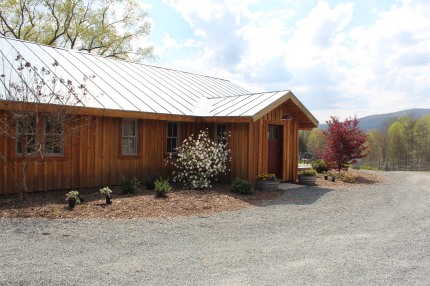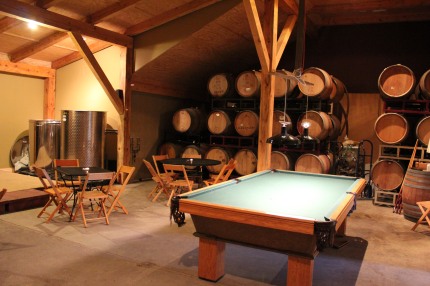Like many people throughout Virginia, we took advantage of the 4th of July weekend to do some wine touring. Our first stop was at Stinson Vineyards. They opened this spring, but their official grand opening was the Fourth of July long weekend, so it looks like we had some fairly good timing with this visit. Before we got there, all I knew was that they were part of the newly formed Appellation (Wine) Trail and that they had Gryffon’s Aerie meat for sale in their tasting room. What we found were some solid wines that have us excited to see what develops at Stinson over the next few years.

The tasting room is small, but with multiple tasting stations they seem well set up to handle a number of visitors at one time. I also like some of the “farm-style” touches throughout the space such as the milk bottle light in the center of the room. That said, the space may start to feel small before too long.
Once we made our way to an open tasting station, the first wine, a ’10 sauv blanc ($22) was poured. There are only a few sauv blancs in VA that I’ve really enjoyed, so I didn’t hold out a lot of hope for this one, but the nose was really promising. I notes lemon, some grass, and a hint of the boxwood/cat pee that you often find with this grape. When I sipped the wine, however, it was a bit watery and all the flavors were muted. We then tried the ’10 rosé ($20) from 100% mouvedre. I got a light fruity nose with a hint of smokiness that took me by surprise. Ont eh palate, I mostly noted pink grapefruit. This was my winner of the tasting, and it seems perfect for all the hot weather and grilling that seem to define VA summers.

We then tasted the ’10 chard ($20) – 25% of which was aged in new french oak. The wine was fine, but it didn’t rock my world or particularly stand out. I noted a light floral oak nose with stronger oak notes on the palate. There was a bit of apple/pear in the middle, but the finish returned to the oak with a hit of vanilla. The final white was the ’10 Sugar Hollow White ($15) which is a blend of Petit Manseng and Rkatsitelli with about 1-1.5% residual sugar. This wine was too cold to get much of a nose, but I noticed a lot of nice fruit flavors – peach, apricot, and lime primarily. This is a great summer sipper that’s not too sweet and would likely please many.
We then moved on to reds with the ’10 cab franc ($22). This was a solid VA cab franc, but it doesn’t particularly stand out or do it for me. I noted a ton of black cherry on the nose and some black pepper joined the party once I started to sip. There was a also a smokey tobacco finish. We then tried a ’10 pinot noir from Ankida Ridge Vineyards, a guest wine from a winery in southwestern VA that plans to open this fall. I’m one of those people who believes that pinot noir has no business being grown in VA (with the possible exception of some being harvested very early for sparkling wine), but Anika Ridge must have some kind of interesting micro-climate going on. The wine struck me as incredibly overoaked, but underneath all that wood there was some really nice fruit (mostly dark berry). I’m not sold on this wine, but I’m definitely curious to try a few vintages.

Our tasting ended with the ’10 petit manseng dessert wine ($25 for 375ml) with 9% residual sugar. I noted peach, apricot, and pineapple and generally described the wine as a tropical fruit salad in a glass. As I revisited the sample, I altered this slightly to be canned peaches in syrup with a bit of honey and pineapple juice on the finish. I found it very enjoyable, but we drink so little dessert wine that I have to be really moved to buy any. FYI, this wine as aged in acacia barrels (don’t you just love trivia?).

Stinson is brand new, and they’re still making wine with fruit purchased elsewhere (although many established wineries do this as well). As their own vines mature and they start to develop standing relationships with growers, it will be interesting to see how their style of wine evolves. That said, I can think of far worse places to spend an afternoon sitting on a patio and sipping some refreshing pink (or lightly sweet white) wine with friends.











